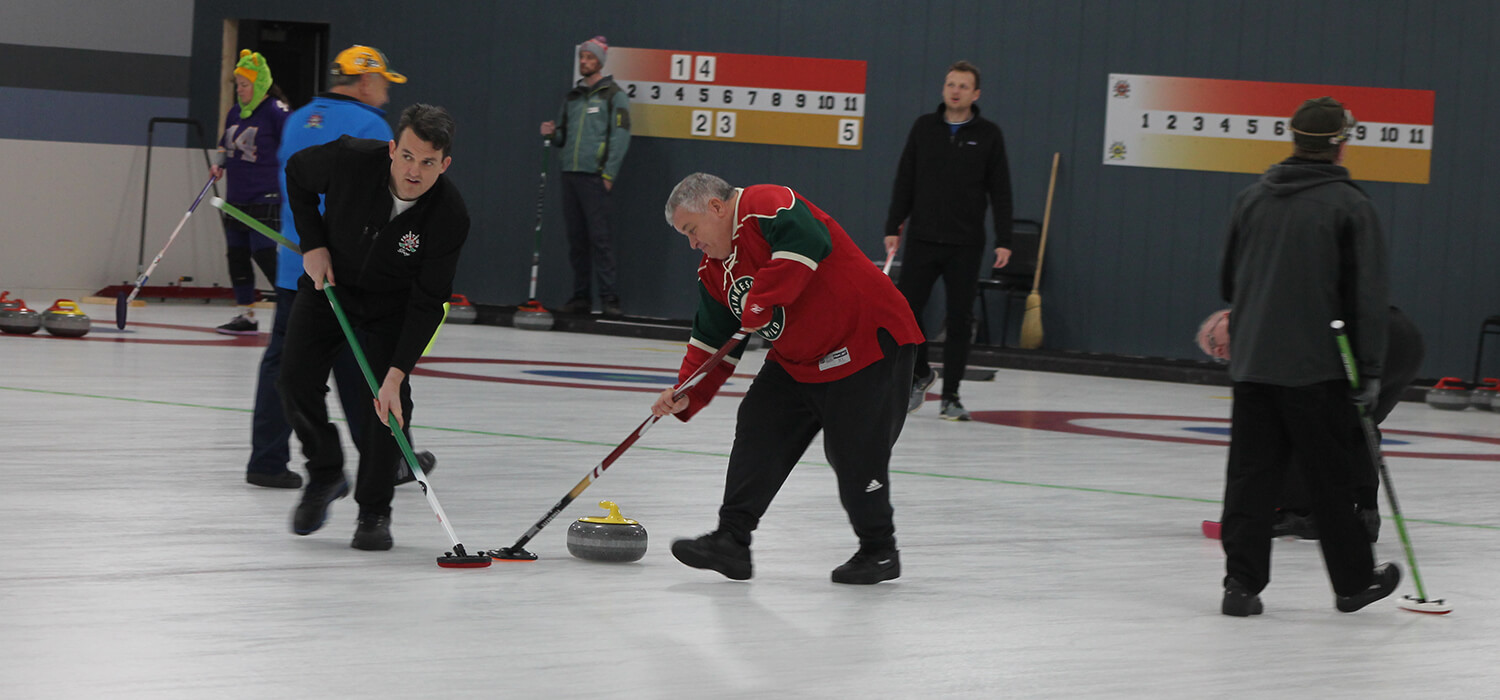At the Frogtown Curling Club Off Site Link in St. Paul, members eat, drink and socialize. They curl, too, but the sport itself seems like more of an afterthought.
In the club’s “warming room,” adjacent to its rink, there is a cluster of round tables and chairs. Club member Peter Hovland says the furniture choice was deliberate.
“If you notice, the tables are round – that’s on purpose,” he says. “It’s more fun to sit around in a circle to talk.”
“You’re all facing each other,” interjects Club President Bruce Alexander.
The club has been up and running for nine years and is housed in the former Biff Adams Arena on Western Avenue in St. Paul. On a recent Thursday night, a handful of members amble around the rink, prepping the club’s sheets – what curling is played on – for an upcoming tournament. Alexander has been at the club since 11:30 a.m. making last-minute preparations.
The club has close to 600 members and hosts league play that starts in the fall and goes through the spring. Frogtown also hosts “learn-to-curl” events open to the public. Interest in the sport is alive and well in the Twin Cities. According to Alexander, there are five dedicated clubs – those with their own rink – around the Metro.
There’s no question that members at the Frogtown club love to curl, but at its core the activity is a gathering that allows players to enjoy what its members call a “very social” sport.
“It’s very much become a community,” says Alexander.
Stones, Sweepers and Sheets
Curling is an Olympic sport, but it doesn’t share the same popularity as hockey or soccer. It is played on a “sheet” that measures approximately 150 feet long and roughly 15 feet wide. At the end of the sheet is a group of concentric circles, the innermost of which is called the “button.”
The object of the game is to throw your “stone” – a 42-pound granite weight – into the vicinity of the concentric circles, referred to as the “house.” Once the stone is thrown, two members of the team “sweep” in front of the stone in an attempt to fine tune the throw. Sweeping can make the stone go straighter and farther.
Each team has four members who each get two throws during an “end,” which is the equivalent to an inning in baseball or a quarter in other sports. Ten ends are played in Olympic curling; there are eight in league play. At the conclusion of each, the team with the most stones closest to the center of the house wins.
“There is, surprisingly, a lot of strategy,” said Alexander. “There’s going around rocks, hitting rocks, placing rocks out in front so the other team can’t get to a certain part of the house. Almost never will you see a rock go straight.”
Frogtown member Jay Ewen says he’s drawn to the sport because it’s something he will be able to continue into old age.
“This is something I can do until I’m 60, 70. That’s the appeal,” he said. “When I see other people out here that are curling into their late sixties, early to mid-seventies, that’s great.”
Ewen adds that it’s not uncommon to find yourself curling against an Olympian, either. Hovland recalls one year when the club found out it had a world-renowned athlete in its league.
“Our first year, there was this one girl who was amazing. We curled the whole year and then the Olympics were on, and I’m scrolling around, and on the Olympic curling website, there’s her throwing,” said Hovland. “She was in our league – no wonder she beat us.”
Who’s Buying the First Round?
The Twin Cities has a strong curling community, and Frogtown’s recent bump in membership reflects that. The club just added a new sheet – its sixth in the arena – making room for 20 additional teams. When the club opened registration for the extra spots, it was filled in seven minutes, according to Alexander.
The game’s social aspect is a big part of curling’s popularity. Before and after games, teammates and opposing players will gather in the warming rooms to socialize, eat and drink. Hovland said players will often bring a crockpot full of food to share with the group.
“The game is just a way to figure out who buys the first beer,” said Hovland.
Members compared curling to golf or bowling, and threw out words like “polite” and “etiquette” when describing it.
“You start the game with a handshake and you finish the game sitting around the table,” said member Clint Andera. “I don’t know of any other sport where you (socialize) with the team you played.”
Andera says, too, that it’s not uncommon for teams to “pause” a game midway through to take a break in the warming room. Sometimes, he says, “you might not even go back out and finish the game.”
There’s a refreshing dash of irreverence at the club. The new sheet is referred to as Sheet “Eh,” as a nod to Canadian phrase placed at the end of sentences. It was “baptized” with Labatt’s, Ewen laughs.
This kind of frivolity is widespread at the club. A healthy amount of light-heartedness, coupled with curling’s social aspect, is what keeps members coming back. And, as Andera points out, there’s no shortage of conversation among players.
“The one thing curlers like to talk about is curling,” he says.


